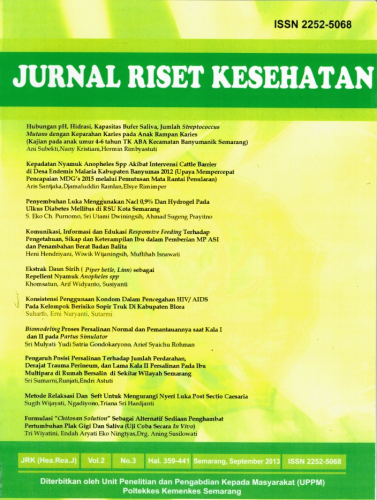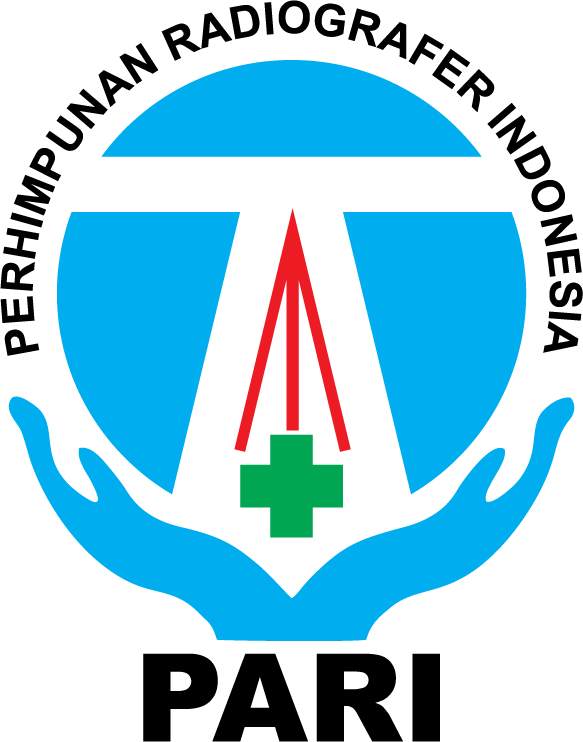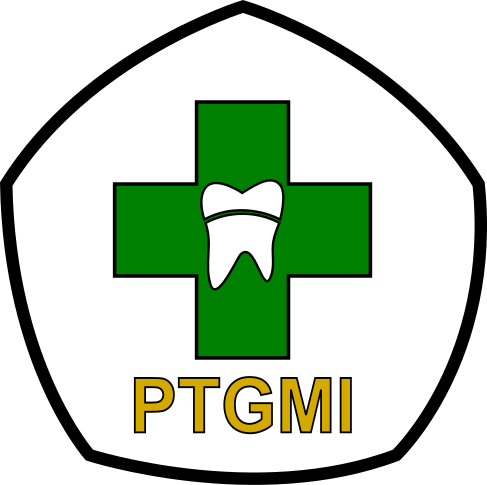PARENTAL KNOWLEDGE TOWARDS CHILDREN’S DENTAL AND ORAL HYGIENE
Abstract
Dental and oral hygiene problem is the leading cause of daily activities disruption in children such as missing school, bad learning concentration, appetite and nutritional intake. Knowledge of dental and oral hygiene should be given at early age in family by the parents. The aim of our work was to determine relationship between parents’ knowledge and dental hygiene of the SDLB children (children with special needs). We undertook this research with analytical survey. A cross-sectional design was carried out. The sampling method was total sampling namely parents of children with special needs and the children as many as 80 people. Chi-Square test was performed to analyze the data. The results show that the knowledge of parents about dental and oral hygiene is not good (85%), while the dental and oral hygiene in children with special needs is poor (85%). Based on the Chi-Square Test, it produces a p-value of sig (2-sided) = 0.002 in the test, so it can obtain a p-value (probability value) from the test (p = 0.002 < = 0.05) so that Ho is rejected. In conclusion, a relationship between parental knowledge and oral hygiene in children with special needs does exist.
Keywords
Full Text:
PDFReferences
Abdat, M., & Ramayana, I. (2020). Relationship between mother ’ s knowledge and behaviour with oral health status of early childhood. Padjadjaran Journal of Dentistry, 32(3), 166–173. https://doi.org/10.24198/pjd.vol32no2.24734
Al-batayneh, O. B., Al-khateeb, H. O., Ibrahim, W. M., & Khader, Y. S. (2019). Parental Knowledge and Acceptance of Different Treatment Options for Primary Teeth Provided by Dental Practitioners. Frontiers in Public Health, 7(November), 1–8. https://doi.org/10.3389/fpubh.2019.00322
Alhabdan, Y. A., Albeshr, A. G., & Yenugadhati, N. (2018). Prevalence of dental caries and associated factors among primary school children : a population-based cross-sectional study in Riyadh , Saudi Arabia. Environmental Health and Preventive Medicine, 23(60), 1–14.
Bayarsaikhan, Z., Cruz, S., Neff, J., & Chi, D. L. (2015). Transitioning from pediatric care to adult care for adolescents with special health care needs: dentist perspectives (part 2). Pediatr Dent., 37(5), 447–451.
Bozorgmehr, E., Hajizamani, A., & Mohammadi, T. M. (2013). Oral Health Behavior of Parents as a Predictor of Oral Health Status of Their Children. ISRN Dentistry, (741783), 1–5. https://doi.org/10.1155/2013/741783
Duijster, D., Jong-lenters, M. De, Verrips, E., & Loveren, C. Van. (2015). Establishing oral health promoting behaviours in children – parents ’ views on barriers , facilitators and professional support : a qualitative study. BMC Oral Health, 15(157), 1–13. https://doi.org/10.1186/s12903-015-0145-0
Hegde, A. M., Babu, A. A., Mohammed, A., John, A., Singh, K., C., P. V, & Shetty, S. (2015). Special Needs of Special Children-Parental View. Journal of Health and Allied Sciences NU, 05(02), 038–044. https://doi.org/10.1055/s-0040-1703887
Hendaus, M. A., Shaltout, D., Yasrab, D., Al-noubani, A., Hamad, S. G., Alamri, M., & Alhammadi, A. H. (2020). Parental Perception of a Dental Home for Children with Special Needs. Pediatric Health, Medicine and Therapeutics, 11, 379–384.
Isong, I. A., Luff, D., Perrin, J. M., Winickoff, J. P., & Ng, M. W. (2012). Parental Perspectives of Early Childhood Caries. Clinical Pediatrics, 51(1), 77–85. https://doi.org/10.1177/0009922811417856
Kamilah, E. N. (2015). DISTRIBUSI NILAI r. Pengaruh Keterampilan Mengajar Guru Terhadap Hasil Belajar Siswa Pada Mata Pelajaran Akuntansi Universitas, 91.
Kubota, Y., Jareonpituak, S., Narksawat, K., Satitvipawee, P., & Durward, C. (2017). Status , knowledge , attitudes , and practices of 12-18-year old orphaned children pertaining to dental caries in an dental clinic by non-governmental organization at Phnom. Oral Health Care, 2(2), 1–4. https://doi.org/10.15761/OHC.1000117
Lai, B., Tan, W. K., & Lu, Q. S. (2018). Clinical efficacy of a two-year oral health programme for infants and toddlers in Singapore. Singapore Med J, 59(2), 87–93. https://doi.org/10.11622/smedj.2017045
Maharani, D. A., Zhang, S., Gao, S. S., & Chu, C. (2019). Dental Caries and the Erosive Tooth Wear Status of 12-Year-Old Children in Jakarta , Indonesia. International Journal of Environmental Research and Public Health, 16(2994), 1–10. https://doi.org/10.3390/ijerph16162994
Mahat, G., & Bowen, F. (2017). Parental Knowledge about Urban Preschool Children ’ s Oral Health Risk. Pediatric Nursing, 43(1), 30–34.
Mchugh, M. L. (2013). The Chi-square test of independence. Biochemia Medica, 23(2), 143–149. https://doi.org/10.11613/BM.2013.018
Ministry of Health of Indonesia. (2019). Faktor Risiko Kesehatan Gigi dan Mulut. InfoDATIN, 1–6. Retrieved from https://pusdatin.kemkes.go.id/download.php?file=download/pusdatin/infodatin/infodatin-gigi.pdf
Mota-veloso, I., Nogueira, R., Eduardo, C., Alca, P., Aparecida, S., Ramos-jorge, M. L., & Oliveira-ferreira, F. (2012). Research in Developmental Disabilities Does intellectual disability affect the development of dental caries in patients with cerebral palsy ? Research in Developmental Disabilities, 33, 1503–1507. https://doi.org/10.1016/j.ridd.2012.03.026
Ningrum, V., Bakar, A., Shieh, T., & Shih, Y. (2021). The Oral Health Inequities between Special Needs Children and Normal Children in Asia : A Systematic Review and. Healthcare, 9(410), 1–12. https://doi.org/10.3390/healthcare9040410
Oberoi, S. S., Sharma, G., & Oberoi, A. (2016). A cross-sectional survey to assess the effect of socioeconomic status on the oral hygiene habits. J Indian Soc Periodontol, 20(5), 531–542. https://doi.org/10.4103/0972-124X.201629
Pini, D. D. M., Fröhlich, P. C. G. R., & Rigo, L. (2016). Oral health evaluation in special needs individuals. Einstein (Sao Paulo), 14(55 54), 501–507. https://doi.org/10.1590/S1679-45082016AO3712
Priya, M. M., Kumar, P., & Saraswathi, S. (2018). Assessment of parental oral health knowledge , attitude , and behavior. Journal of Pharmacy Research, 12(1), 10–13.
Rogéria, A., Castilho, F. De, Luiz, F., Souza, T. De, & Puppin-rontani, R. M. (2013). Influence of family environment on children ’ s oral health : a systematic review ☆. Journal de Pediatria, 89(2), 116–123. https://doi.org/10.1016/j.jped.2013.03.014
Sarvas, E. (2017). Assessing Caries Risk in Children With Special Needs. Decisions in Dentistry, 3(3), 48–52.
Syreen, S., Anwar, A., Ahmad, G., & Rahman, M. (2018). Prevalence of Dental Caries among Children Residing in Muslim Dominated. Journal of Medical Science and Clinical Research, 06(12), 817–819.
Urwannachotima, N., & Hanvoravongchai, P. (2020). System dynamics analysis of dental caries status among Thai adults and elderly. Journal of Health Research, 34(2), 134–146. https://doi.org/10.1108/JHR-05-2019-0097
Van Chuyen, N., Van Du, V., Van Ba, N., Long, D. D., & Son, H. A. (2021). The prevalence of dental caries and associated factors among secondary school children in rural highland Vietnam. BMC Oral Health, 21(1), 1–7. https://doi.org/10.1186/s12903-021-01704-y
Vellappally, S., Gardens, S. J., Kheraif, A. A. Al, Krishna, M., Babu, S., Hashem, M., … Anil, S. (2014). The prevalence of malocclusion and its association with dental caries among 12-18-year-old disabled adolescents. BMC Oral Health, 14(123), 1–7.
World Health Organization (WHO). (2016). WHO Expert Consultation on Public Health Intervention against Early Childhood Caries. Retrieved from https://apps.who.int/iris/bitstream/handle/10665/255627/WHO-NMH-PND-17.1-eng.pdf
Yeung, P. M., Wong, V. C. N., Mcgrath, C. P., Yiu, C. K. Y., & Lee, G. H. M. (2019). Oral health status of children with epilepsy in Hong Kong. J Invest Clin Dent, 10(February), 1–8. https://doi.org/10.1111/jicd.12479
Zamani, A. R. (2010). Oral Health for Children with Disabilities and Special Needs. California Childcare Health Program, 1–2.
Zhang, S., Chau, A. M. H., Lo, E. C. M., & Chu, C. (2014). Dental caries and erosion status of 12-year-old Hong Kong children. BMC Public Health, 14(7), 1–7.
DOI: https://doi.org/10.31983/jrk.v10i2.7625
Article Metrics
Refbacks
- There are currently no refbacks.
Copyright (c) 2021 Jurnal Riset Kesehatan




















































